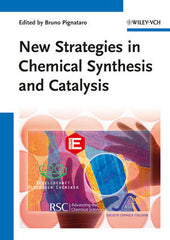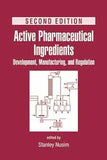New Strategies in Chemical Synthesis and Catalysis by Bruno Pignataro (Editor)
New Strategies in Chemical Synthesis and Catalysis
Award 2010. The other volume concerns the area of Nanotechnology/Material Science and is titled: Molecules at Work.
This book contains the contributions of selected young chemists from the field of synthetic chemistry. The contributions are grouped
under the three following umbrella topics:
Synthetic Methods
Catalysis
Combinatorial and Chemical Biology
This volume is an indispensable read for all organic and inorganic chemists, biochemists, chemists working with/on organometallics,
and Ph.D. students in chemistry interested in seeing what tomorrow's chemistry will look like.
List of Contributors XIX
Part I Synthetic Methods
1 Electrospray and Cryospray Mass Spectrometry: From Serendipity to Designed Synthesis of Supramolecular Coordination and Polyoxometalate Clusters 3
Haralampos N. Miras and Leroy Cronin
1.1 Introduction 3
1.2 Background to ESI-MS 5
1.2.1 Background to CSI-MS 5
1.3 Application of High-Resolution ESI-MS and CSI-MS to Polyoxometalate Cluster Systems 6
1.3.1 Probing Protonation Versus Heteroatom Inclusion with ESI 7
1.3.2 Solution Identification of Functionalized POMs 10
1.3.3 Solution Identification of New Isopolyoxotungstates and Isopolyoxoniobates 11
1.3.4 Solution Identification and Isolation of Mixed-Metal/Valence POMs with CSI-MS 13
1.3.5 Mixed-Metal/Valence Hetero-POMs V2 ⊂ {M17V1} 14
1.3.6 Periodate-Containing POMs 17
1.3.7 Probing the Formation of POM-Based Nano-Structures 17
1.3.8 Mechanistic Insights into POM Self-Assembly Using ESI- and CSI-MS 19
1.4 Species Identification and Probing Structural Transformations in Multi-Metallic Systems 25
1.5 Future Challenges and Conclusions 27
References 29
2 Efficient Synthesis of Natural Products Aided by Automated Synthesizers and Microreactors 33
Shinichiro Fuse, Kazuhiro Machida, and Takashi Takahashi
2.1 Efficient Synthesis of Natural Products Aided by Automated Synthesizers 33
2.1.1 The Process of Automating the Supply of Synthetic Intermediates 34
2.1.2 Efficient Synthesis of a Cyanohydrin Key Intermediate for Taxol Using Automated Synthesizers 40
2.1.3 Efficient Synthesis of a Cyclic Ether Key Intermediate for Nine-Membered Masked Enediyne, Using an Automated Synthesizer 44
2.1.4 List of Reactions Successfully Performed in Automated Synthesizers 50
2.2 Continuous-Flow Synthesis of Vitamin D3 52
2.3 Conclusions 55
Acknowledgments 55
References 56
3 Chemoselective Reduction of Amides and Imides 59
Shoubhik Das
3.1 Introduction 59
3.2 Reduction of Tertiary Amides 61
3.3 Reduction of Secondary Amides 70
3.4 Dehydration of Primary Amides 73
3.5 Reduction of Imides 74
3.6 Conclusion 76
Acknowledgment 76
References 76
4 Ionic Ozonides – From Simple Inorganic Salts to Supramolecular Building Blocks 79
Hanne Nuss and Martin Jansen
4.1 The Forgotten Oxygen Anion 79
4.2 The Synthesis of Ionic Ozonides 80
4.3 The Structural Variety of Ionic Ozonides 83
4.3.1 Simple Binary and Pseudo-Binary Ozonides 83
4.3.2 Cs5([12]crown-4)2(O3)5 – from Simple Salts to Supramolecular Building Blocks 87
4.4 Magnetic Properties 89
4.5 Conclusions and Perspectives 93
References 94
5 Chemistry and Biological Properties of Amidinoureas: Strategies for the Synthesis of Original Bioactive Hit Compounds 97
Daniele Castagnolo
5.1 Amidinoureas: an Introduction 97
5.2 Amidinoureas in Chemistry 99
5.3 Synthetic Strategies for the Preparation of Amidinoureas 102
5.3.1 Hydrolysis of Biguanides 103
5.3.2 Reaction of Guanidines with Isocyanates 103
5.3.3 Hydrolysis of Cyanoguanidines 105
5.3.4 Reaction of Acyl-S-Methylisothiourea with Amines 106
5.3.5 Reaction of Di-Boc-Guanidines with Amines 107
5.4 Macrocyclic Amidinoureas 110
5.4.1 Guanylated Polyamines 111
5.4.2 Conversion of Di-Boc-Guanylated Diamines into Amidinoureas 113
5.4.3 Synthesis of Cyclic Amidinoureas 115
5.4.4 Synthesis of Macrocyclic Amidinoureas from Di-Boc-Monoguanylated Triamines 118
5.4.5 Biological Properties of Cyclic Amidinoureas 120
5.5 Perspectives 123
Acknowledgments 124
References 124
Part II Catalysis
6 DNA Catalysts for Synthetic Applications in Biomolecular Chemistry 129
Claudia Höbartner and P.I. Pradeepkumar
Abbreviations 129
6.1 Introduction 129
6.2 In vitro Selection of Deoxyribozymes 130
6.3 Scope of DNA-Catalyzed Reactions 132
6.4 Synthetic Applications of RNA-Cleaving Deoxyribozymes 133
6.5 DNA-Catalyzed Linear Ligation of RNA 137
6.6 DNA-Catalyzed Synthesis of 2,5-Branched Nucleic Acids 140
6.6.1 2,5-Branched RNA 143
6.6.2 2,5-Branched Nucleic Acids Containing RNA as Scaffold and DNA as Adaptor 144
6.6.3 2,5-Branched DNA 145
6.6.4 2,5-Branched Nucleic Acids Containing DNA as Scaffold and RNA as ‘‘Adaptor’’ 146
6.7 DNA-Catalyzed Synthesis of Nucleopeptide Conjugates 146
6.8 Mechanistic Aspects of DNA Catalysis 147
6.9 Conclusions and Outlook 150
References 150
7 Iron-Catalyzed Csp3 –H Oxidation with H2O2: Converting a Radical Reaction into a Selective and Efficient Synthetic Tool 157
Laura Gómez
7.1 Introduction and Scope 157
7.2 Environmentally Benign C–H Oxidation 158
7.3 Inspiration from Nature 158
7.4 Mechanistic Considerations 159
7.5 Bioinspired C–H Oxidation Catalysts 161
7.5.1 Porphyrinic Catalysts 161
7.5.2 Non-porphyrinic Mononuclear Iron Catalysts 162
7.6 Perspectives 171
References 172
8 Hydrogen Bonds as an Alternative Activation 175
Eugenia Marqués-López and Raquel P. Herrera
8.1 Introduction 175
8.1.1 Chiral Thiourea/Urea Organocatalysts 175
8.2 Thiourea Catalysts 178
8.2.1 Friedel–Crafts Alkylation Reaction 178
8.2.2 Michael Addition Reactions 183
8.2.2.1 Michael Addition Reaction of N,N-Dialkylhydrazones to Nitroalkenes 184
8.2.2.2 Michael Addition Reaction of Formaldehyde N,N-Dialkylhydrazones to β, γ -Unsaturated α-Keto Esters 186
8.2.2.3 Hydrophosphonylation Reaction of Nitroalkenes 188
8.2.3 Aza-Henry Reaction 191
8.3 Conclusions 193
Acknowledgments 194
References 194
9 Electrosynthesized Structured Catalysts for H2 Production 201
Patricia Benito, Francesco Basile, Giuseppe Fornasari, Marco Monti, Erika Scavetta, Domenica Tonelli, and Angelo Vaccari
9.1 Introduction 201
9.2 Preparation of Structured Catalysts 202
9.3 Electrosynthesis 203
9.4 Electrosynthesis of Hydrotalcite-Type Compounds 204
9.4.1 Experimental 204
9.4.2 Ni/Al and Rh/Mg/Al HT Compounds on FeCrAlloy Foams 207
9.4.3 Catalysts 210
9.4.4 Steam Reforming and Catalytic Partial Oxidation of Methane 212
9.5 Summary and Outlook 214
References 215
10 Microkinetic Analysis of Complex Chemical Processes at Surfaces 219
Matteo Maestri
Notation 219
Greek letters 219
10.1 Introduction 219
10.2 Time and Length Scales in Heterogeneous Catalysis 221
10.3 Hierarchical Multiscale Approach for Microkinetic Model Development 223
10.3.1 Microkinetic Model Development 224
10.3.1.1 Prediction of Activation Energies Using the UBI-QEP Semiempirical Method 226
10.3.1.2 First-Principles Assessment of the UBI-QEP Semiempirical Method 227
10.3.2 Meso-Scale and Macroscale: Reaction and Reactor Engineering 229
10.3.3 Hierarchical Multiscale Refinement of the Microkinetic Model 230
10.4 Show Case: Microkinetic Analysis of CH4 Partial Oxidation on Rh 231
10.4.1 Microkinetic Model for the Conversion of CH4 to Syngas 232
10.4.2 Microkinetic Analysis of Isothermal CPOX Data in Annular Reactor 232
10.4.3 Microkinetic Analysis of Autothermal CPOX Data on Foams 239
10.5 Conclusions 241
Acknowledgments 242
References 242
11 Synthetic Potential behind Gold-Catalyzed Redox Processes 247
Cristina Nevado and Teresa de Haro
11.1 Introduction 247
11.2 Gold-Catalyzed Reactions Involving Oxygen Functionalities 247
11.2.1 Oxidation of Alkanes 247
11.2.2 Oxidation of Alcohols to Carbonyl Compounds 248
11.2.3 Oxidation of Alkenes 250
11.2.4 Oxidation of Sulfides to Sulfoxides 251
11.2.5 Oxidation of Gold-Carbene Intermediates 251
11.2.6 Substrates as Internal Oxidants 253
11.3 Gold-Catalyzed Reactions Involving Nitrogen Functionalities 255
11.4 Gold-Catalyzed Reactions Involving C–C Bond Formation 256
11.4.1 Ethynylation Reactions 256
11.4.2 Homocoupling Reactions 260
11.4.3 Cross-Coupling Involving B and Si Reagents 262
11.5 Gold-Catalyzed Reactions Involving Alkene Difunctionalization 264
11.6 Gold-Catalyzed Reactions Involving Halogen Functionalities 264
11.7 Summary and Outlook 266
References 266
12 Transition-Metal Complexes in Supported Liquid Phase and Supercritical Fluids –A Beneficial Combination for Selective Continuous-Flow Catalysis with Integrated Product Separation 273
Ulrich Hintermair, Tamilselvi Chinnusamy, and Walter Leitner
12.1 Strategies for Catalyst Immobilization Using Permanent Separation Barriers 273
12.2 Supported Liquid-Phase Catalysts Based on Organic Solvents (SLP) 274
12.3 Supported Aqueous-Phase Catalysts (SAP) 278
12.4 Supported Ionic Liquid-Phase Catalysts (SILP) 280
12.4.1 Synthetic Methods 280
12.4.2 Characteristics 281
12.4.3 Gas-Phase Applications 282
12.4.4 Liquid-Phase Applications 283
12.5 Supported Liquid-Phase Catalysts and Supercritical Fluids 287
12.6 Conclusion 290
References 292
Part III Combinatorial and Chemical Biology
13 Inhibiting Pathogenic Protein Aggregation: Combinatorial Chemistry in Combating Alpha-1 Antitrypsin Deficiency 299
Yi-Pin Chang
13.1 Introduction 299
13.2 α1-Antitrypsin Deficiency 301
13.2.1 α1-Antitrypsin and Serpin 301
13.2.2 The Polymerization Pathways of Serpins 303
13.2.3 Emerging Therapeutic Strategies 304
13.3 Targeting the s4A Site with the Peptide Annealing Method 305
13.3.1 Functional and Structural Studies of RCLs 305
13.3.2 Smaller RCL-Derived and Non-RCL Serpin-Binding Peptides 306
13.4 Expanding the Molecular Diversity 307
13.4.1 Alanine Scanning, Truncation, and D-Amino Acid Scanning Libraries 308
13.4.2 The β-Strand-Directed Library 309
13.4.3 The Positional Scanning Library 312
13.5 Characterization of the Combinatorially Selected Peptide 314
13.5.1 Validation of the Binding by SPR 314
13.5.2 Cytotoxicity of the Identified Peptide and the Proposed Structure of the Binary Complex 315
13.6 Conclusion and Outlook 316
Acknowledgments 317
References 317
14 Synthesis and Application of Macrocycles Using Dynamic Combinatorial Chemistry 325
Vittorio Saggiomo
14.1 Supramolecular Chemistry 325
14.2 Dynamic Combinatorial Chemistry 326
14.2.1 The Next Step: Applications 330
14.3 Ion Transport across Membranes Mediated by a Dynamic Combinatorial Library 331
References 341
15 Toward Tomorrow’s Drugs: the Synthesis of Compound Libraries by Solid-Phase Chemistry 343
Dagmar C. Kapeller and Stefan Bráse
Abbreviations 343
15.1 Introduction 344
15.1.1 The History of Drug Discovery 344
15.1.2 Characteristics of Druglike Molecules 345
15.1.3 Drug Targets 345
15.1.4 Privileged Structures 347
15.2 Solid-Phase Synthesis of Selected Privileged Structures 347
15.2.1 Introduction to Solid-Phase Synthesis 347
15.2.2 Benzodiazepines 348
15.2.3 Benzopyrans 354
15.2.4 Indoles 360
15.2.5 Pyrazoles 364
15.3 Conclusions and Outlook 371
Acknowledgment 372
References 372
Index 377


















